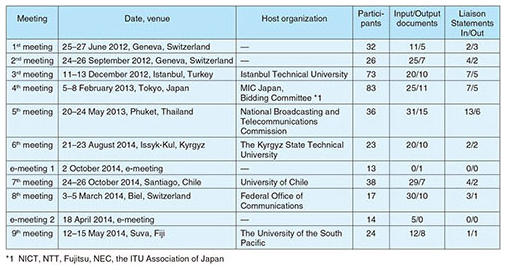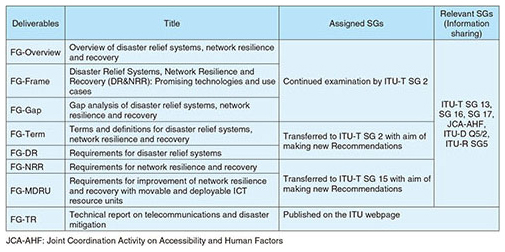 |
|||
|
|
|||
|
Global Standardization Activities Vol. 12, No. 12, pp. 50–55, Dec. 2014. https://doi.org/10.53829/ntr201412gls Results of ITU-T Focus Group on Disaster Relief, Network Resilience and Recovery (FG-DR&NRR)AbstractThe Focus Group on Disaster Relief Systems, Network Resilience and Recovery (FG-DR&NRR) was established within ITU-T (International Telecommunication Union°›Telecommunication Standardization Sector) in January 2012, as a Japanese government initiative, to study international standardization related to disaster response by utilizing information and communication technology (ICT). One of the authors (Noriyuki Araki) served as the chairman of this focus group. By May 2014, the FG-DR&NRR had held a total of eleven meetings (including two electronic conferences) and developed eight deliverables. This article reports the results of the final FG-DR&NRR meeting, provides an outline of the deliverables, and summarizes a plan for future international standardization activities in relation to the use of ICT to cope with disasters. Keywords: ITU, focus group, disaster relief 1. Outline of FG-DR&NRRThe Focus Group on Disaster Relief Systems, Network Resilience and Recovery (FG-DR&NRR) is a time-limited study committee of the ITU-T (International Telecommunication Union–Telecommunication Standardization Sector), which is undertaking an intensive study of new standards related to disaster relief systems and network resilience and recovery by utilizing information and communication technology (ICT) in the event of a disaster. Its establishment was agreed at a Telecommunication Standardization Advisory Group (TSAG) meeting in January 2012. Noriyuki Araki, a co-author of this article, served as the chairman of this FG because Japan was deeply involved in its establishment at TSAG meetings, and NTT has long had a sense of responsibility that motivates it to contribute to society. The management team and Working Groups (WGs) of the FG-DR&NRR are listed in Table 1.
2. Report of 9th FG-DR&NRR meetingThe 9th FG-DR&NRR meeting, the final one, was held at the University of the South Pacific, Suva, Fiji, in May 2014. The organizations from Japan that participated in this meeting were the Ministry of Internal Affairs and Communications (MIC), the National Institute of Information and Communications Technology (NICT), NTT, NEC, and the University of Tokyo. A special session for sharing information about basic policy regarding ICT for disaster response and disaster countermeasures in Fiji and Japan was held at this FG meeting. Information about the disaster response efforts of Telecom Fiji Ltd. (TFL) and the Pacific Island Telecommunication Association (PITA) were incorporated in the use case and requirements deliverables, and disaster countermeasure case studies and the requirements for ICT during disasters in island countries were reflected in the deliverables of the FG-DR&NRR. Moreover, an integrated view of networks supporting disaster relief services (Fig. 1), which includes research and development (R&D) results related to ICT designed to strengthen disaster resistance in Japan, was updated, and an example of the application of information-centric network technology was added to the framework document. Then, at this meeting, the FG-DR&NRR completed seven deliverables including requirements for disaster relief systems. Some technologies proposed by the NTT Group such as a safety confirmation system and a movable ICT resource unit were included in the deliverables. The deliverables are detailed in section 4.
3. Overview of activity of FG-DR&NRRThe FG visited several countries that had suffered major disasters such as earthquakes, tsunamis, landslides, floods, and tidal waves in order to gather information on disaster experiences from all over the world. The meetings held by the FG-DR&NRR are listed in Table 2, which also provides statistical information about the participants, documents, and Liaison Statements. Three ITU workshops on disaster relief systems, network resilience and recovery were also held at the same time as the FG-DR&NRR meetings. Even when no workshops were being conducted, special sessions related to disaster issues were held as part of the FG meeting. At these ITU events, ICT solutions for disaster relief and resilient ICT R&D projects in Japan were introduced, and local experts were invited and information gathered about disaster experiences and requirements for ICT in disaster situations.
4. Summary of deliverablesThe FG-DR&NRR has developed eight deliverables as described below. All these deliverables have been published by ITU-T FG-DR&NRR as technical reports and can be found on the ITU-T website [1]. 4.1 FG-OverviewThis deliverable provides an overview of the activity of FG-DR&NRR, including the objectives and area of study, and an outline of other major deliverables produced by the FG-DR&NRR. It also describes the category classification of ITU-T Recommendations and activities in other organizations outside ITU-T relevant to DR&NRR. This document is useful for understanding the trend in disaster related standardization. 4.2 FG-FrameThis deliverable has five parts. The inputs at FG-DR&NRR meetings are used as the basis of this document, which provides an integrated view of promising technologies for DR&NRR. Parts I to III introduce the specific implementation of disaster relief system tools by public organizations and private citizens during disasters. They also reveal the possibility of maintaining communications through cooperation between fixed, mobile, and satellite communication networks during a disaster, thus ensuring communication capabilities by utilizing public Wi-Fi, home networks, and ad-hoc networks in disaster affected areas, and the transfer of disaster information by employing public broadcasting and digital signage. Information about FG-DR&NRR meeting inputs, which are contained along with brief summaries and references in a common template can be found in Parts IV and V. They are expected to be employed as disaster use cases. 4.3 FG-GapThis document presents current work on disaster relief systems and network resilience and recovery efforts that have been carried out by different standards development organizations (SDOs) and the disaster communication networks and technologies used by other national and international disaster relief bodies. This document identifies gaps related to issues that are not currently receiving sufficient attention in ITU standardization work by using these inputs as a basis. The document also describes technologies for standardization that are well developed and being used for disaster relief systems, network resilience and recovery. 4.4 FG-TermThis document contains terms and definitions relevant to providing a common general understanding of the area of disaster relief systems, network resilience and recovery. It is also designed to support the creation of common terms and definitions in this area. 4.5 FG-DRThis deliverable describes requirements for disaster relief systems including early warning systems that are used for actual and potential victims before, during, and after disasters. To facilitate future enhancements, the document consists of a main body as the general part and describes disaster relief services that need further investigation prior to standardization in annexes. Annex 1, “Disaster message board service,” and Annex 2, “Disaster voice delivery service,” were transferred to ITU-T Study Group (SG) 2 at the TSAG meeting held in June 2013, and work on creating a new ITU-T Recommendation has already begun. It is planned that Annex 3, “Safety confirmation system,” will become standardized. 4.6 FG-NRRThis deliverable describes requirements for network resilience and recovery before, during, and after disasters. To facilitate future improvements, the document consists of a main body as the general part and describes disaster relief services that need further investigation prior to standardization in annexes. 4.7 FG-MDRU (Movable and Deployable Resource Unit)This deliverable introduces an approach designed to improve network resiliency against disasters and to assist network recovery after disasters by packaging movable and instantaneously deployable resources for ICT as one unit. ITU-T SG 15 will begin working on a new ITU-T Recommendation based on this deliverable. 4.8 FG-TR (Technical Report)This technical report is the first report of the ITU-T FG-DR&NRR. It presents a number of case studies related to the performance of public telecommunications systems in recent disasters along with a review of activities related to the use of telecommunications for disaster mitigation and the standards that have been developed by various organizations. 5. Collaboration with other organizations and SDOsFG-DR&NRR has initiated relationships with relevant disaster related organizations and SDOs for information exchange and collaboration by sending Liaison Statements and giving presentations about its FG activities, in particular: ASTAP (Asia-Pacific Telecommunity Standardization Program), IARU (International Amateur Radio Union), IEC (International Electrotechnical Commission), IETF (Internet Engineering Task Force), ISO (International Organization for Standardization), ITU-Telecommunication Development Sector (ITU-D), ITU-Radiocommunication Sector (ITU-R), the aforementioned PITA, TARU (Technical Advisory Response Unit), TTC (Telecommunication Technology Committee), UNDP (United Nations Development Programme), and UNISDR (United Nations International Strategy for Disaster Reduction). It is expected that relationships will be maintained with relevant ITU organizations and related SDOs and other bodies to enable effective standardization work to be undertaken in this area. 6. Future work plan6.1 Transfers of deliverables to different Study GroupsAt a meeting in June 2014 of ITU-T SG 2, the parent Study Group of this FG, it was agreed that the eight FG-DR&NRR deliverables would be taken over by the relevant ITU-T Study Groups as indicated in Table 3. Some of these deliverables include promising technologies, so it was therefore decided that ITU-T SG 2 and SG 15 would start making relevant Recommendations as soon as possible. The deliverables also include study items related to network architecture, accessibility, and security issues in disaster situations, so it was agreed that these deliverables would be sent to ITU-T SG 13, SG 16, SG 17, JCA-AHF (Joint Coordination Activity on Accessibility and Human Factors), ITU-D Q5/2 (Question 5/2) and ITU-R SG 5 for information sharing.
6.2 Future activitiesThe requirement documents of FG-DR&NRR deliverables—FG-DR, FG-NRR, and FG-MDRU—detail specific characteristics of promising technologies that have already been installed in the field or for which demonstration experiments have been carried out with a view to practical use. The “Disaster message board service” and “Disaster voice delivery service,” which were transferred to ITU-T SG 2 at the TSAG meeting in June 2013, are currently being studied in ITU-T SG 2 with the aim of creating a new ITU-T Recommendation. In addition, work will start on Annex 3 of FG-DR concerning a “Safety confirmation system” for business continuity plans and a “Movable ICT resource unit” of FG-MDRU, which is intended to achieve quick recovery of communication services in disaster affected areas, in order to create new ITU-T Recommendations and achieve early standardization in ITU-T SG 2 and SG 15. 7. ConclusionFG-DR&NRR was terminated in May 2014. At the ITU-T SG 2 meeting held in June 2014, it was agreed that the eight FG-DR&NRR deliverables would be taken over by the relevant ITU-T Study Groups. It was difficult to cover the entire study area related to this FG within its limited lifetime, because the study area that FG-DR&NRR dealt with is very wide and diverse. Therefore, it is necessary to continue examining this area in the relevant ITU-T Study Groups. However, much information has been collected in countries with disaster experience, including Japan, such as in the large-scale disaster of the Great East Japan Earthquake and tsunami. This information, as well as the extensive Japanese R&D results concerning ICT in the event of disaster, have been reflected in the FG-DR&NRR deliverables in order to cope with disasters throughout the world. The authors consider that the FG activity has helped to specify the study items that should be standardized in the future, and to move certain technologies toward new ITU-T Recommendations. NTT hopes that worldwide efforts will be made to promote the use of ICT to combat disasters and mitigate the damage that they cause. The authors believe that prompt action regarding the publication of FG deliverables as ITU-T Recommendations will contribute to the promotion of ICT use and prevent some of the damage that could be caused by future disasters. Reference
|
|||






